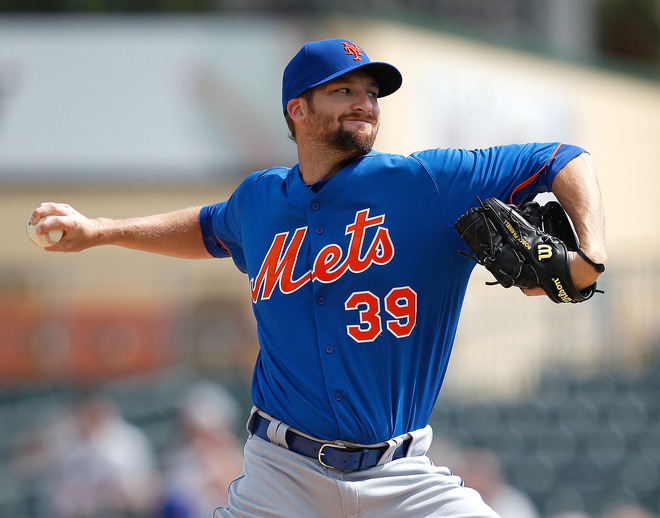
As promised, here’s my second installment of economically building the Mets’ bullpen. You can read my first part here if you need to brush up or simply missed it.
Last week, I showed how opportunity cost could help identify the best relief candidates for a particular inning. I concluded by saying that Scott Atchison should pitch in the 8th inning. He cannot be used as the next best alternative to compare to now. Additionally, the 8th inning cannot be compared against since that inning has hypothetically been decided. This is done because he and his inning can’t be compared against since they are both, hypothetically, in use.
I’m going to evaluate the 7th and 9th innings this time. Once the best potential candidate for the 7th is found, it makes it simple to figure out who should pitch in the 9th. Again, this is all based on the concept of opportunity cost. To refresh, opportunity cost is an economic term that means the highest valued alternative foregone to pursue an activity. This is not an exact science, but it’s another way to further examine the tools that the Mets have to work with. I think they have some quality arms.
Let’s take a look at the potential options for the 7th, which all meet the 10-inning-minimum rule:
- Scott Atchison: 2.76 ERA • 0.99 WHIP • .220 BA • .258 OBP • 3.33 K/BB
- Pedro Feliciano: 2.92 ERA • 1.16 WHIP • .222 BA • .314 OBP • 1.75 K/BB
- LaTroy Hawkins: 4.26 ERA • 1.39 WHIP • 2.80 BA • .315 OBP • 2.00 K/BB
- Brandon Lyon: 3.86 ERA • 1.43 WHIP • .263 BA • .323 OBP • 3.00 K/BB
- Bobby Parnell: 2.20 ERA • 1.43 WHIP • .237 BA • .333 OBP • 1.56 K/BB
Since the only inning remaining for comparison is the 9th, let’s look at those stats as well:
- Bobby Parnell: 1.90 ERA • 0.91 WHIP • .193 BA • .333 OBP • 4.40 K/BB
- Frank Francisco: 5.50 ERA • 1.53 WHIP • 1.53 • .257 BA • .247 OBP – 2.41 K/BB
- Pedro Feliciano: 3.60 ERA • 1.70 WHIP • .325 BA • ..386 OBP • .2.50 K/BB
- Brandon Lyon: 1.42 ERA • 0.82 WHIP • .182 BA • .217 OBP • 6.00 K/BB
Right off the bat, it’s apparent that Lyon looks best in the 9th. The 7th looks like a tossup between Parnell and Feliciano. Let’s assume that Parnell would be the top choice for two reasons: Parnell’s numbers are more consistent throughout the 7th, 8th and 9th innings and Feliciano hasn’t pitched in two years.
- Bobby Parnell: 2.20 ERA • 1.43 WHIP • .237 BA • ..333 OBP • 1.56 K/BB
- Pedro Feliciano: 2.92 ERA • 1.16 WHIP • .222 BA • .314 OBP • .1.75 K/BB
Differential for Parnell: ERA -.72 • WHIP +0.27 • BA +.015 • OBP +.019 • K/BB -0.19
Depending on what you value will determine whom you find as the best potential candidate. The general consensus, I would think, is Parnell though. So now Parnell would be compared to his own statistics in the 9th—which are compared to the statistics of the next best alternative. That alternative would be the newly acquired Brandon Lyon. Here are their lines:
- Bobby Parnell: 1.90 ERA • 0.91 WHIP • .193 BA • .333 OBP • 4.40 K/BB
- Brandon Lyon: 1.42 ERA • 0.82 WHIP • .182 BA • .217 OBP • .6.00 K/BB
Differentials all favor Lyon: ERA -0.48 • WHIP -0.09 • BA -.011 • OBP -.116 • K/BB +1.60
If we’re talking about Parnell, all those numbers would be negative because that’s what would be given up for playing Parnell over Lyon in the 9th.
Based on the analysis, it would make sense to pitch Parnell in the 9th because the opportunity cost is less severe. But factoring in what the cost would be for removing Lyon in the 9th changes things. The differences that favor Lyon in the 9th (against Parnell) would be lost. Additionally, Parnell’s negatives would be added and Feliciano’s numbers would be used for the 7th inning instead. I won’t bog you down more with those numbers, but I have done them and they’re less beneficial.
In conclusion, the best potential candidates for the Mets bullpen in 2013 would be Parnell in the 7th, Atchison in the 8th and Lyon in the 9th. This is all from the economic perspective of opportunity cost. It’s also based on their averages from those particular innings last season.
Like I mentioned though, baseball isn’t played based on economic models. I believe Parnell will have the first shot at closing games in 2013. The Mets have some good relief options—like the ones mentioned. They also have quality up-and-comers that are also vying for a spot in the bullpen, which will make for good competition. It’ll be tough to decide who will pitch where, but having all those options is one of those good problems—one that the Mets didn’t really have in 2012. You can never have enough good pitching.
What are your thoughts on the Mets bullpen in 2013?














